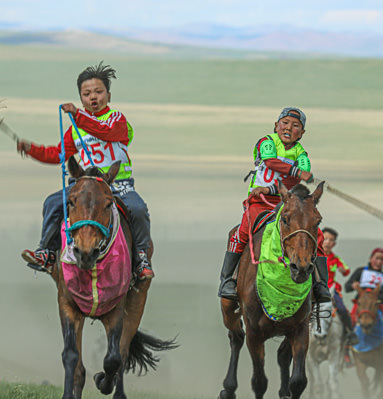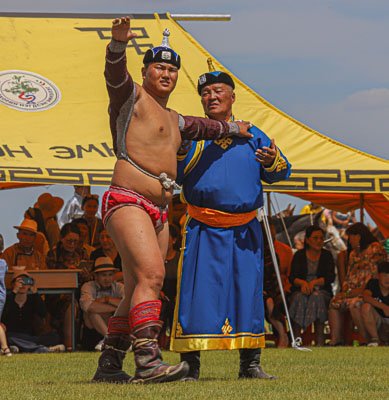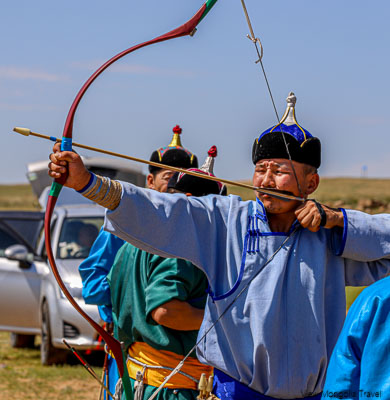What does the Mongolian Naadam Festival symbolize?
Naadam Festival is the most popular national holiday Mongolians celebrate national independence and historical anniversaries and inherit the tradition and nomadic culture for the next generations. The Naadam Festival symbolizes national integrity.
Naadam Festival allows travelers to mingle with Mongolians and observe the authentic traditional culture while attending the non-touristic event.
Our website visitors and readers planning to attend the Naadam Festival will get the most experiential information and advice on how to enjoy and understand the festival and make your holiday memorable and filled with unique experiences and activities.
We arrange tours, including Ulaanbaatar's main Naadam Festival and a local Naadam Festival in northern Mongolia by the beautiful lake Khuvsgul.
What are the three events of the Naadam Festival? Naadam Festival sports
The Naadam is locally termed "Eriin Gurvan Naadam," which means “Three Manly Sports.” The three sports are horse racing, wrestling, and archery. Later added the Knucklebone shooting game. Thus, Naadam Festival comprises 4 national spots.
Although it is called Three Manly Sports, women can participate in horse racing, archery, and ankle-bone shooting, but not in wrestling.
When was the first Naadam Festival? Naadam Festival History
The origin of the Naadam festival is indeed ancient. In olden times, the Mongolian kings and military generals used to train the warriors and their vital war tool horses while feasting and competing in the three manly traditional sports.
Chinese reliable source wrote about the first Naadam celebration fact of the Hunnu Empire (209 BC Mongol Empire).
The Naadam celebration was handed down in 1206 when Temuujin enthroned Genghis Khan after building the Great Mongol Empire.
In 1939, Mongolians celebrated the religious Naadam Festival, declaring 5-year-old Zanabazar as a Mongolian spiritual leader. It was the origin of today’s religious Danshig Naadam.
During the 16th century Buddist introduction and 17th century Manchu control, Mongolians celebrated the Naadam Festivaл in the back of the mountain and Ovoo (religious cairns) worshipping.
At the beginning of the 20th century, Mongolians annually celebrated the Naadam Festival in honor of religious and state leader Bogd Khan with a conception of secretly organizing meetings.
One year after the Mongolian People Revolution in 1921, Naadam has been celebrated as an annual national holiday throughout the country since 1922.
Each town, each province, and each city has been annually celebrating the Naadam Festival since the adaptation of the Mongolian National Naadam law in 2003.
Which Naadam Festival is the best? Local Naadam vs Countryside Naadam
The Naadam in Ulaanbaatar allows its audience to see the colorful and marvelous opening ceremony, parades, cultural performances, evening shows, and state-range sports competitions.
It is exciting to see the finals of the competitions on the second day of Naadam. Especially the wrestling finals are ignored and skipped in tour packages. Maybe this is because the tournament can last as late as 10 to 11 PM due to no weight limitation in Mongolian wrestling. If you wish, you can see the wrestling finals within our tour packages to see and feel the real festivity and excitement of the audience in the Naadam stadium while having a packed dinner.
If your timing does not allow attending Ulaanbaatar’s main Naadam Festival on 11 and 12 July, we recommend you take part Khui Doloon Khudag horse trainers’ Naadam on 13 July. Khui Doloon Khudag is located 30 km west of Ulaanbaatar. Khui Doloon Khudag Naadam allows the attendees to see horse racing and wrestling in more approachable conditions. Please note that no archery and knucklebone shooting at horse trainers Naadam. As usual, you can taste Naadam meals, buy souvenirs, and watch the traditional performance. We suggest this Naadam for photographers.
Countryside Naadam, in particular, the town Naadam is the most beautiful Naadam. You can see and photograph the sports and events from a closer distance, observe culture and tradition while mingling with the locals and nomads, and feel their hospitality. Many people know each other in the countryside. Thus, it is pretty to see them greeting each other and chatting. Some town Naadams allow foreigners and tourists to attend sports games.
When is the Naadam Festival? Why do Mongolians celebrate the Naadam Festival on different days?
The official Naadam celebration annually takes place throughout the country on 11 and 12 July.
Mongolia has 21 provinces and 330 soums (small administrative divisions/towns). All provinces and towns celebrate their festivals respectively. Some administrative units celebrate their festival on different dates depending on special celebration occasions, anniversaries happening at certain times, weather, pastureland, animal conditions, etc. Additionally, celebrating the Naadam Festival on different dates than Ulaanbaatar’s Naadam allows wrestlers, archers, and racehorses to compete in different Naadams and makes the Naadam sport more competitive.
The weather and pastureland conditions influence the Naadam celebration date. Most local Naadam Festival dates become clear by June.
Below are a few local Naadams with fixed dates.
Khatgal Naadam Festival – One of the most attractive Naadams annually celebrated at the Khovsgol Lake shore on 10 and 11 July.
We will update the information when the Naadam dates are confirmed.
Where is the Naadam festival in Mongolia? The Naadam Festival arena
Ulaanbaatar Naadam Central Stadium, Knucklebone Shooting Pavilion, and Archery Field are located in the same area, 1.5 m south of Sukhbaatar Square, a convenient walking distance from most downtown hotels. Wrestling continues for 2 days on 11 and 12 July. Knucklebone shooting continues for 4 days between 9 and 12 July. The archery tournament starts on 7 July and ends on 12 July.
The horse race finish line is located at Khui Doloon Khudag, 30 km west of Ulaanbaatar. The best way to see the horse race is to take a package tour from tour operators. Alternatively, you can take the Khui Doloon Khudag bus at certain bus stations. Taxis will not work because they require permission when entering Khui Doloon Khudag. Alternatively, you may call the taxi call centers and ask if you can get Khui Doloon Khudag permission to taxi.
How to get Naadam ticket?
It is not easy to get Ulaanbaatar Naadam Festival tickets. A Naadam ticket is required when watching the Naadam Festival opening, closing, and wrestling. Other sports do not require entry tickets. Although, your car needs permission to drive to the horseracing area. Countryside Naadam Festivals do not require tickets. We recommend you take a Naadam package tour from tour operators to simplify things.
If you are an independent traveler, you may ask for help from your guest house or hotel to get the Naadam tickets. Naadam tickets are available online starting on 1 July. But it requires several attempts, or many people ended failing because everybody tries to get online tickets. Otherwise, you can get the Naadam tickets from a ticket reseller at a higher price. The reseller tickets are available at advertisement websites, Facebook groups, and Central Stadium on 11 July morning.
How do Mongolians celebrate Naadam?
5-7 days off-work holiday days happen during the Naadam Festival. Thus, many travels to scenic places, lakes, and river shores with family and friends to camp and cook Mongolian barbeque. The ger camps are full of tourists and Mongolians.
People in towns and cities cook the Naadam dish Khushuur at home and watch Naadam sports on TV.
Additionally, many people dress in colorful traditional clothes and visit the city and town Naadam Stadiums to see the Naadam sports, taste Naadam field Khuushuur, Airag, barbecue, and other delicacies. Children like to play at Naadam playgrounds. In the countryside, people attend the Naadam Festival riding their nicest-looking horses.
Events around the Naadam Festival
The Naadam is not solely about sports; visitors also see different games and exhibitions, attend shows, purchase souvenirs, and traditional clothes, sample traditional meals and drinks, including the fermented mare milk Airag, shop Naadam trade and buy souvenirs.
July 11 and 12 are National Naadam Festival celebrations days. Even though, the Naadam starts on 7 July with archery tournaments and ends on 13 July evening. The Naadam Festival program helps you schedule your Naadam Festival.
Who organizes Naadam Festival?
Mongolians celebrated the Naadam Festival even during the communist regimes. The National Naadam is funded by the government budget. Local government budgets and community fundraising fund the local Naadams. All provinces and towns celebrate their own Naadam Festivals. Around 22,400 wrestlers, 105,000 horses ridden by child jockeys, and 9,500 archers compete in the festivals nationwide.











